 Fall has arrived in Sweetwater Grove and the bees are busy with winter preparations. They’ve also added fruit to the menu, discovering that many forest creatures love it almost as much as the sweet honey their hive is famous for.
Fall has arrived in Sweetwater Grove and the bees are busy with winter preparations. They’ve also added fruit to the menu, discovering that many forest creatures love it almost as much as the sweet honey their hive is famous for.
Honey Buzz: Fall Flavors is a modular expansion for the game Honey Buzz from Elf Creek Games. Note that the base game is required in order to play this expansion.
Expansion Overview:
Fall Flavors includes five modules, which players can mix and match into the base game. I’ll give a brief rules overview of each. Note that each module is also compatible with the advanced and solo play rules.
Sweetwater Sunset is the first module and players should always use this when including any other modules from the expansion. It includes a sunset board with a sun token and a reference card. This replaces the original rules for the game-end trigger. Certain events will progress the sun token, and when it reaches the last space on the board the game end is triggered. Events that advance the sun token are: a stack of orders becomes empty, a resource reaches its lowest value, the last nectar tile is collected, a stack of hive tiles becomes empty, the last nectar cap is claimed, and the festival board becomes full.
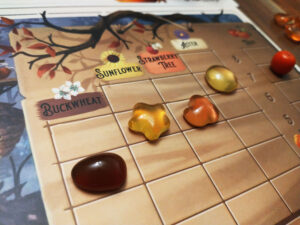
The next module, Fall Fruit, adds, you guessed it, fruit to the game. This module uses a new woodland board with a fall theme and a different layout for the nectar tiles. There’s also a fourth space for a new order type—fruit orders. When setting up the woodland board, in addition to the nectar tiles, fruit tokens are placed on the field. When a player takes the Forage action, instead of gaining nectar, they may choose to gain fruit if their token is on or adjacent to a fruit token (note that pollen is not used with this expansion). The fruit tokens are not removed but stay on the woodland board for the duration of the game. When collected, fruit of the matching type is taken from the supply. Fruit can be sold in the market, with an income bonus for selling a set of all three fruit types- apple, pear, and pumpkin. Or players can choose to fill a fruit order, which will be a combination of honey and fruit, for points.
The Autumn Leaves module presents another way to score points via a new type of objective, foliage cards, which will be placed next to the Queen’s contest cards. When using this module you replace six hive tiles of each type from the base game with the new leafy hive tiles and shuffle them into their respective stacks. These tiles depict leaves in any of three colors and will award points at the end of the game based on the condition listed on the fall foliage card, such as scoring for most leaves of each type.
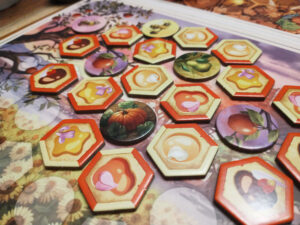
The Nectar Caps module gives an alternate option when players trigger an accounting (gain money) action. They may, instead of taking five coins, choose to take the topmost nectar cap and place it on a nectar tile. Once a nectar tile is capped it can no longer produce honey for the rest of the game, but it will give players additional points. During setup, the caps are arranged in order of descending point value, from 12 to 5, so the players who cap early will gain the most points. Additionally, the players who placed the most and second most nectar caps will receive ten and five points, respectively, at game’s end.
Harvest Festival allows players to retire worker bees to the festival board at the end of their turns. When you place a bee here you can either take a toast card or perform a decree (wild) action. Toast cards are drawn randomly and placed on the board during setup. When a player takes a card, they score it immediately based on the current game state; for example, “Gain 3 coins per type of nectar in your hive,” would trigger based on how much nectar is currently in your hive, not at game’s end. Once bees are retired to the festival board they remain there for the rest of the game.
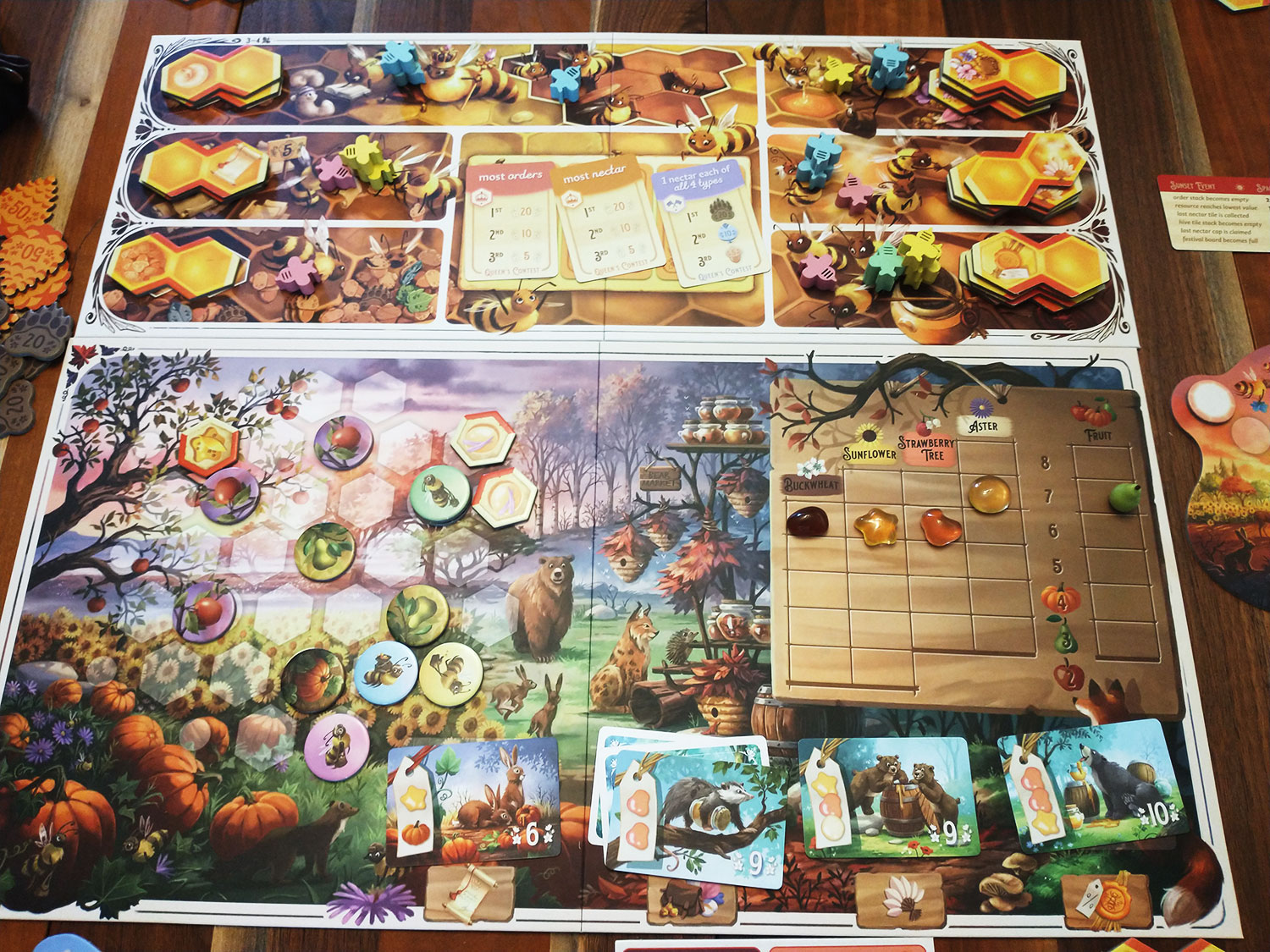
Game Experience with the Expansion:
This is a pretty robust expansion, so we have a lot to unpack! Let’s start with the sunset module. This is a simple but welcome addition to the game. Since there is a lot more going on with the expansion, especially if you add all modules, it makes sense that there would be multiple ways to trigger the game end. I did find that the sun tends to not move much during the first half of the game, then moves rapidly during the second half, especially because emptying an order stack advances the sun twice, and order stacks tend to run out around the same time (at least, during our plays). That isn’t really a change since orders were one of the original game end triggers anyway, but I find it can give the illusion you have more time than you actually do, especially in higher player count games. This module is mandatory if using any of the other modules, and I have no problem with that since it simply adds one small board and is easy to manage.
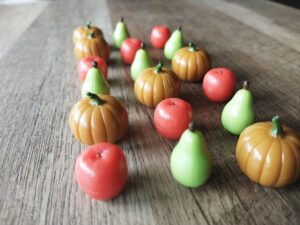
Then there’s the shining star of Fall Flavors, the Fall Fruit module. You could say this is the meat of the expansion, while the rest of the modules feel like the designer was just having fun. Fall Fruit essentially replaces nectar, which was a rather uninteresting resource, with fruit. Not only are these gummy-like tokens deliciously appealing, but this module is solid. It adds purpose to your turn when you don’t, or can’t, take a nectar tile, and, unlike with pollen, the type of fruit you take matters thanks to specific fruit order cards, as well as market value. The gorgeous artwork on the new harvest board doesn’t hurt, while the new tile layout which places nectar in a circular arrangement around the fruit tokens, allows players to move their forage tokens in six different directions, opening up more options. This is definitely the best module of the bunch, so much so that I would almost always choose to play with it. We even taught our kids the base game with this included (they liked the pretty fruit) and they had no problem catching on.
The best module is followed by my least favorite, Autumn Leaves. This module adds busyness to an already busy game. The one change I do like about it is that it gives a little bit more motive to take specific hive tiles when you may not otherwise have a clear choice. Tiles with leaves will help with end game scoring, so when you see one turn up at the top of a hive stack, that location gets more appealing. But most of the time I found myself paying very little attention to the fall foliage scoring condition, because there is already so much to think about with this game, and this is just another piece in an already abundant point salad. I think this expansion will go over best with players who are very familiar with the game and won’t mind the confusion the leaves can add when you’re finishing a segment to trigger actions. It also adds to set up time, though the rules suggest leaving them in all the time and just ignoring the leaf symbols when not using the module- which I do not do because they’re too busy and confusing. Points for prettiness though!
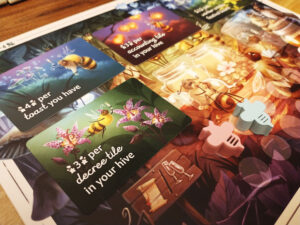
Nectar Caps are an interesting feature which can come into play if you have a nectar type that is no longer profitable. There’s a slight push-your-luck factor with how long you hold off on capping nectar, if you do it early you get extra points, but should you use your nectar to produce honey a few more times? Meanwhile, another player might choose to cap before you. Ultimately, this is just another way to score points, but I think some players will like that it opens up an alternate purpose for otherwise unwanted nectar tiles. This is another one I would suggest for experienced players because, while it’s a small change, it does add another element of strategy.
Harvest Festival is my second favorite module of the bunch. Having an alternative placement for your workers- and a permanent one- adds an interesting twist to the game. Like the nectar caps, timing here matters, because if someone else takes a festival card you had your eye on, you’ll miss out, but you’re also giving up a worker. This is something you definitely start to think about during the latter half of the game and it adds a nice element of tension. It can be especially beneficial on the last turn of the game if you have extra workers but no good way to gain points- if nothing else, you can take the decree action to make a final sale or just gain five coins. When using Fall Flavors I will probably always include this module.
Final Thoughts:
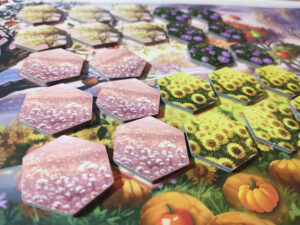
If you are a Honey Buzz lover Fall Flavors is absolutely for you. It does not fundamentally change the mechanisms of the game, but works within the original design space, while the modular nature boosts replay value exponentially. It’s not simply a “more stuff” expansion—though some modules feel that way—nor a “bandage on a problem” expansion—though some modules do make certain actions more meaningful and interesting.
Rather, I’d say it’s an enhancement expansion, honing the original gameplay in a way experienced players will appreciate. I would not recommend this if you’re new to Honey Buzz, but I suggest playing the base game several times first to determine if you like it, because this only builds upon that experience. If you dislike Honey Buzz, I’m not sure Fall Flavors will change your mind, unless you disliked it because of a specific aspect addressed by the expansion.
The downside here is that this adds more to a game that already has a lot going on. Some modules in Fall Flavors do increase what can already be a tedious setup, though they don’t increase actual playtime. If you felt the original game was too busy, or too much of a point salad, you won’t like this expansion. Autumn Leaves and Nectar Caps felt like just another way to add points to the game that wasn’t really necessary. The good news is, you can choose only to use the modules that suit you and ignore the rest, or change it up from time to time with different combinations. If you like the game enough to play it regularly, I think this expansion is worth it, if only for the Fall Fruit and Festival modules.
 Hits:
Hits:
• Adds more meaning to some actions
• Increased replay value
• Beautiful artwork and components
Misses:
• Increases setup time
• Adds more busyness
• A couple of modules felt like “more of the same”





















